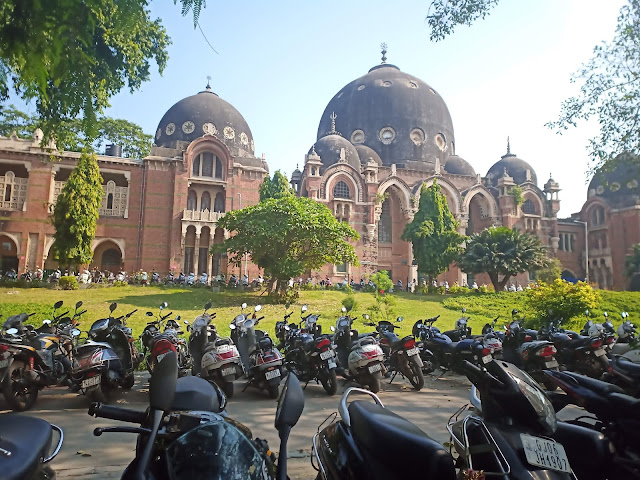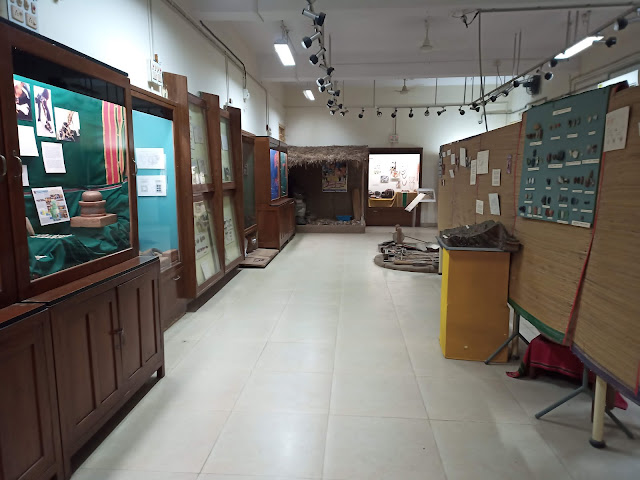An Archaeologist's Guide to Gujarat, India: Vadodara
After leaving the capital of India, Gujarat was my next stop. I boarded an IndiGo plane from Delhi to Baroda, now officially known as Vadodara after the name was changed in 1974. Strangely, no one in Delhi knew what I was talking about when I mentioned that my destination was Vadodara. Maybe the news of the name change hasn't reached them yet.
I couldn't help but have the song Istanbul (Not Constantinople) in my head with the lyrics replaced with "Vadodara (Not Baroda)" throughout my time here.
MSU Baroda
My first stop in Vadodara was to visit the Head of Archaeology at the Maharaja Sayajirao University Baroda. The university developed in 1949 from the earlier Baroda College, which was established in 1881. MSU Baroda is the only university in Gujarat where teaching is conducted solely in English. This was a relief for me, as my Hindi is not up to scratch and my Gujarati is non-existant.
The university is named after Maharaja Sayajirao Gaekwad III, who was the Mahajara of the historic Baroda State from 1875 to 1939. He had set aside significant funds for the building of a university in Baroda for students from rural areas of the state. The university was completed by the Maharaja's grandson, Pratapsinghrao Gaekwad, who named the university after his grandfather.
The rather eye-catching university Faculty of Arts building is visible from the main road. Wandering around the campus, I saw that there were a lot of students sitting and chatting, enjoying the warm weather (and apparently not bothered by the intense humidity). Being a student myself, I like visiting university campuses in other cities and countries because they always have a certain laid back yet collegiate atmosphere.
Within the university's Department of Archaeology is an archaeological museum with two galleries. One is dedicated to the history of Buddhism in Gujarat and India, and the other to the Indus Valley civilisation, a large part of which was based in regions that now fall within the state of Gujarat. Although small, the museum is well worth a visit, and opens Monday to Friday from about 11am onward.
In the Indus Valley gallery in particular, I saw a range of models showing aspects of Indus life. One highlight for me was this model of a traditional Harappan bead-making workshop. The Harappans were skilled craftspeople and used these types of workshops to produce a whole range of beautiful beads and jewellery.
Lakshmi Vilas Palace
While in Baroda I also visited the Lakshmi Vilas Palace, a large palace complex built by Maharaja Sayajirao Gaekwad III (the maharaja the university is named after) in 1890. The palace is built in the Indo-Saracenic/Indo-Gothic architectural style which was used by British architects in the late 19th century for public and government buildings, and palaces.
Trying to take a photo from the outside of the building proved a challenge. The palace is so immense that I couldn't fit the entire thing in my camera frame, but I think you get the picture.
Trying to take a photo from the outside of the building proved a challenge. The palace is so immense that I couldn't fit the entire thing in my camera frame, but I think you get the picture.
Inside (no photos allowed), are elements of the palace that have been maintained, including a throne room, very extensive armoury, and ballroom, complete with opulent decorations. The forecourt of the palace is particularly heavily decorated, with marble statues, mosaics and a hanging chandelier, all the basic items you would expect in the home of the very wealthy. The royal family, who are descendants of Maharaja Sayajirao, still live in the parts of the building that are not open to the public.
An entry ticket costs 200 rupee (about 4 AUD or 3 USD) and includes an audio guide for the palace. For an additional 150 rupee (about 3 AUD or 2 USD), foreigners can also visit the Maharaja Fatesingh Museum which is also located on the estate, although on my visit I didn't have time to go to the museum. The palace is open from 10am to 5pm, and the museum from 10:30am to 5:30pm, from Tuesday to Sunday.
Baroda Museum & Picture Gallery
The Baroda Museum & Picture Gallery is located in the Sayaji Baug park, a large park in the centre of the city boasting a zoo, deer park and miniature train. The museum was established in 1894 and is inspired by the focus on art, craftmanship and nature of the Victoria & Albert Museum and the Science Museum of London.
The museum displays a range of objects, including art and sculpture from South Asia, East Asia and Europe. Interestingly, the museum has a small Egyptian gallery complete with an Egyptian mummy. Upstairs is the natural history collection, containing (somewhat dusty) specimens of all manner of flora and fauna. While leaving the museum, I noticed an arrow pointing to the basement level, which surprisingly led me to the enormous skeleton of a blue whale. Photos are not permitted in the museum, so the only way to see its contents is to visit in person.
The Baroda Museum & Picture Gallery is open daily from 10:30am to 5:30pm, and costs foreigners 200 rupees (about 4 AUD or 3 USD).
When leaving the museum, you can also check out the Deer Park, which hosts many white-spotted deer.
Parsi Agiary
Across the road from the hotel I was staying in, I noticed a compound with large grounds that provided paid parking spaces and was hosting a Diwali market selling handicrafts. Looking at the map, the building in this compound is labelled as the Parsi Agiary, which turned out to be a Zoroastrian fire temple. This was the first private Parsi temple to be built in the city, and was completed in 1923.
The building was commissioned by the state contractor of the Baroda State who, prior to the construction of the temple, used the site for a brick manufacturing business. Farmaji, the contractor, stipulated when the temple was built that it should be managed and funded by his family members only. Continuing till today, his descendants manage the temple. The fire that was lit in the temple upon its construction is still alight today. As per Parsi tradition, only Parsis can enter the temple so I was limited to viewing it from the outside.
The Parsis are a Zoroastrian community that migrated to the region of Gujarat, India from Persia during the Muslim conquest of Persia in 636-651 CE. They were given refuge here by the local people. Zoroastrianism is one of the oldest continuously practiced religions, based on the dualism of good and evil, with Ahura Mazda as the supreme creator. In this tradition water and fire are the tools of ritual purity, and various purification ceremonies involving these elements are the basis of ritual life.
In Summary
Now its Vadodara, not Baroda turned out to be a nice little part of my trip. Being mainly a university city, there isn't too much to actually see but what I did see taught me some intersting stuff about the history of the city and its place in Gujarat. The university and its museum were my favourite thing to see here, and I would recommend anyone passing through the region to stop by and take a look.











Comments
Post a Comment